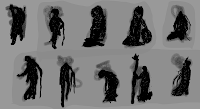Despite reading some of Hans Christian Andersen's short stories before, I came away from The Tinder-Box quite confused. Having been expecting an ending with a strong moral (in a similar vein to
The Girl Who Trod on the Loaf), it was a little surprising when the Soldier, set up to be the perfect Veruca Salt-style character, wasn't undone by his own greed.
The story begins with a soldier coming back from war, when he meets a witch by a great tree. The witch tells him of a hall beneath the tree, containing unimaginable riches. The witch offered to lower him into the tree in exchange for her tinderbox, which was also in the hall. The soldier descends, and in the first room, finds a chest full of copper pieces, guarded by a dog with teacup-sized eyes. After moving the dog, he fills his pockets with copper, and proceeds to the next chamber. In there, he moves the second dog, with mill-wheel-sized eyes, and empties his pockets of copper, replacing them with silver. In the third room, the soldier repeats this, instead with gold pieces, and then, tinderbox in hand, the witch brings him back up.
He asks the witch what she will do with the tinderbox, and when she refuses to tell him, he decapitates her, bringing the tinderbox with him. In the nearby town, he lives in luxury, until, after a while, the money he took from the hall was gone. Upon striking the tinderbox to light a small candle, the dog that guarded the copper pieces appeared before him. The dogs that the box called to him would fulfil his every wish, and so, when he wishes to see the princess, who is locked in a copper tower, the first dog brings her to him. The king, fearing that his daughter would fall in love with a commoner, tasks one of the servants with watching over the princess. When the dog takes her the next night, the servant follows, drawing a large cross on the soldier's door with chalk.
When the soldier sees the chalk cross, he takes chalk and draws a cross on the doors of all the other houses in town, in order to conceal himself, and so, when the king and queen look the next morning, they cannot find the correct house. That evening, the queen ties a bag of flour around the princess' neck and cuts a hole in it, so that they could follow the trail she left when she was taken. Sure enough, the next morning, the soldier is identified and arrested, to be hanged later. The soldier pays a shoemaker's boy to fetch the tinderbox for him, and so when he is to be hanged, he requests to smoke a pipe one last time. Of course, on striking the tinderbox, the three dogs appear, and, upon the soldier's request, kills the soldiers, king and queen. The villagers, terrified, proclaim him king, and allow him to marry the princess, after which she becomes queen. (This, apparently, she is pleased with, despite her husband brutally murdering her mother and father to gain his position.)
...and the story ends there, something I hadn't been expecting. Whilst the soldier was very clever; drawing the crosses on the other houses' doors and persuading the executioner to allow him to strike the tinderbox, his greed and willingness to murder both the monarchy and the witch, made me feel as though he was the morally worst character in the story, and yet he receives everything he wishes for. On the other hand, he took opportunities as and when they were presented; he descended into the hall despite the fact that the witch could have simply dropped him to his death, he killed the witch who, potentially, could have used the tinderbox to kill him and take the gold, he used the shoemaker's boy to retrieve the tinderbox, and finally, he escaped his execution to live a life as king. In that way, you could take the moral to be that those who act on opportunities are successful, however I do feel that I am trying to find a moral in a story that is simply meant to be enjoyed for what it is.























